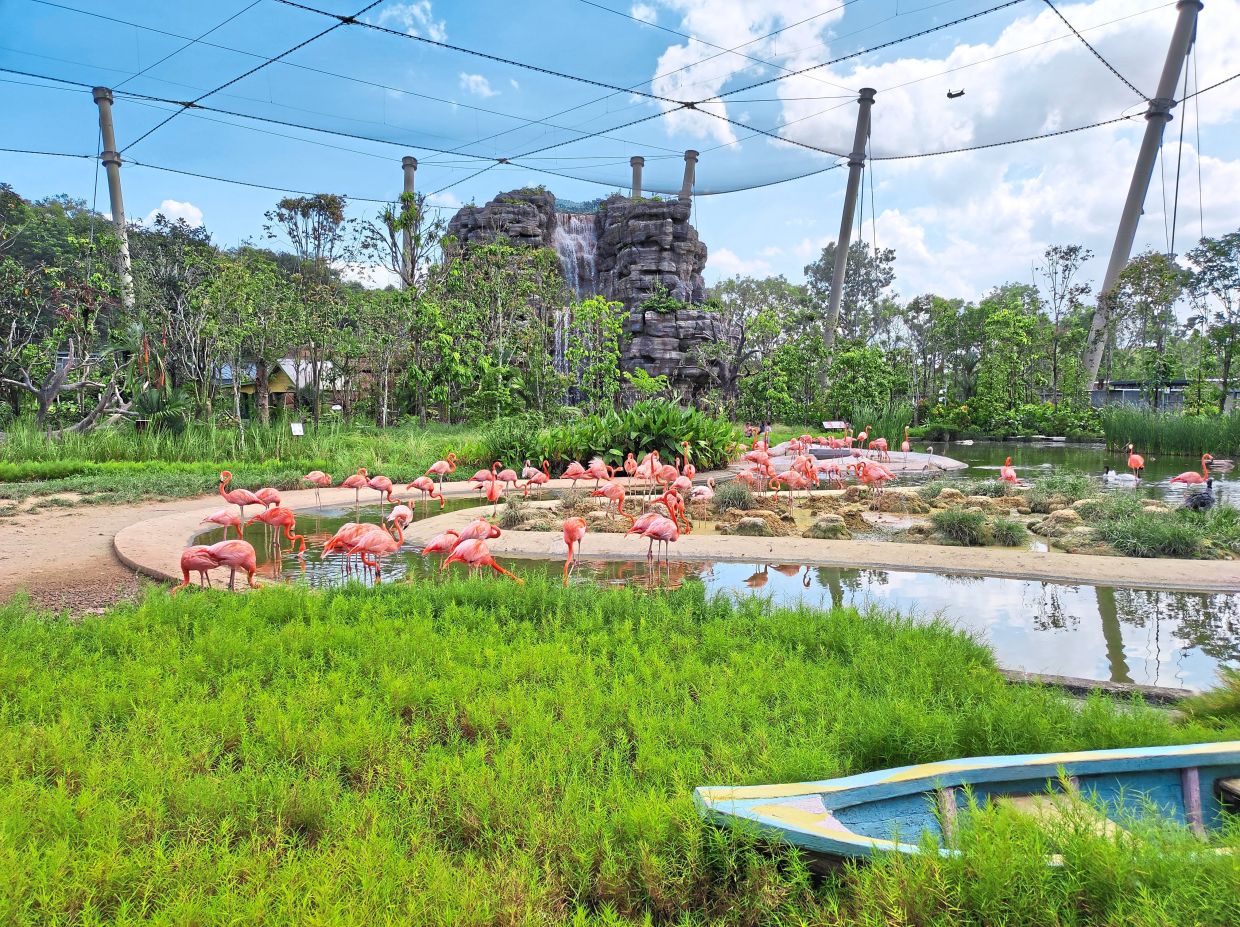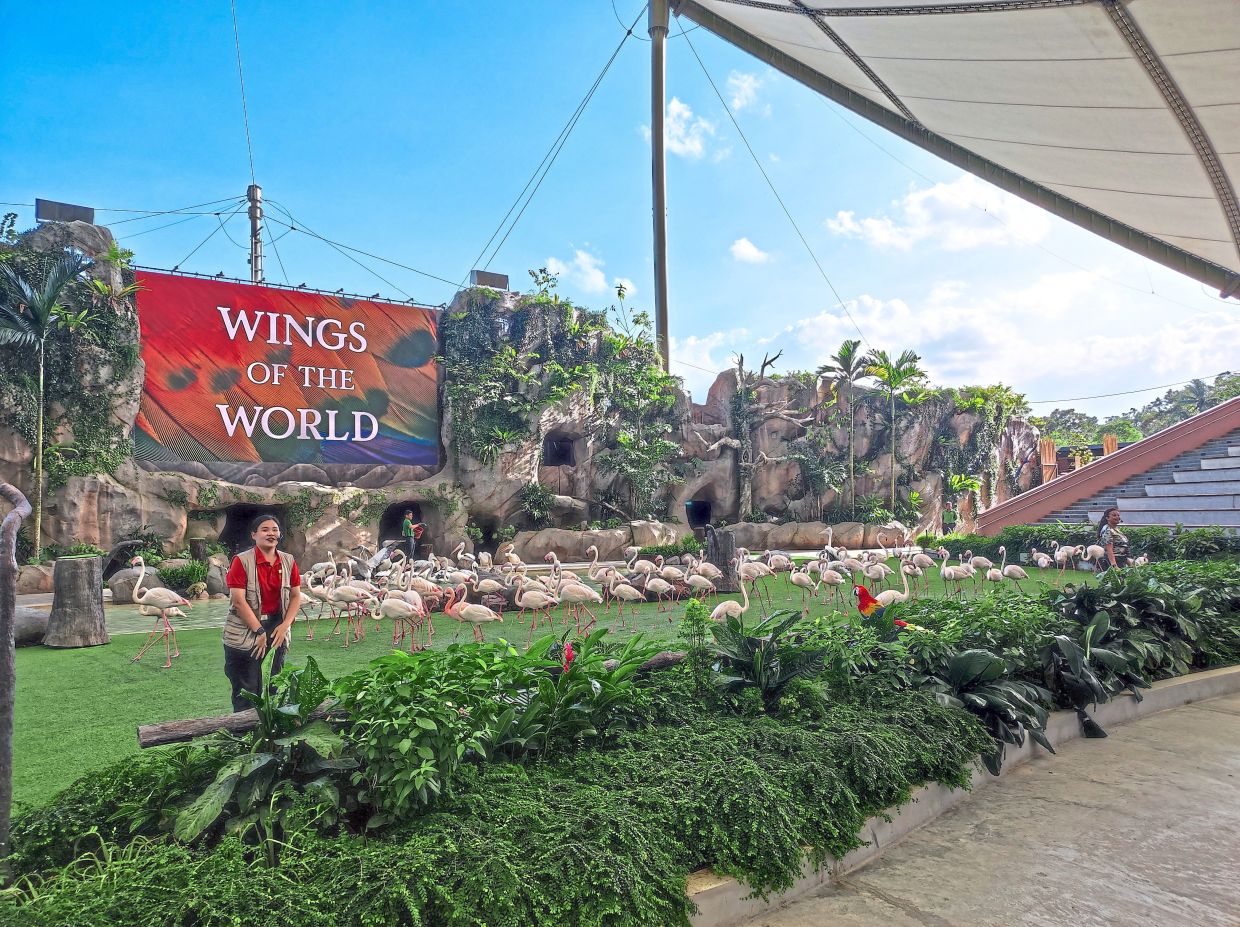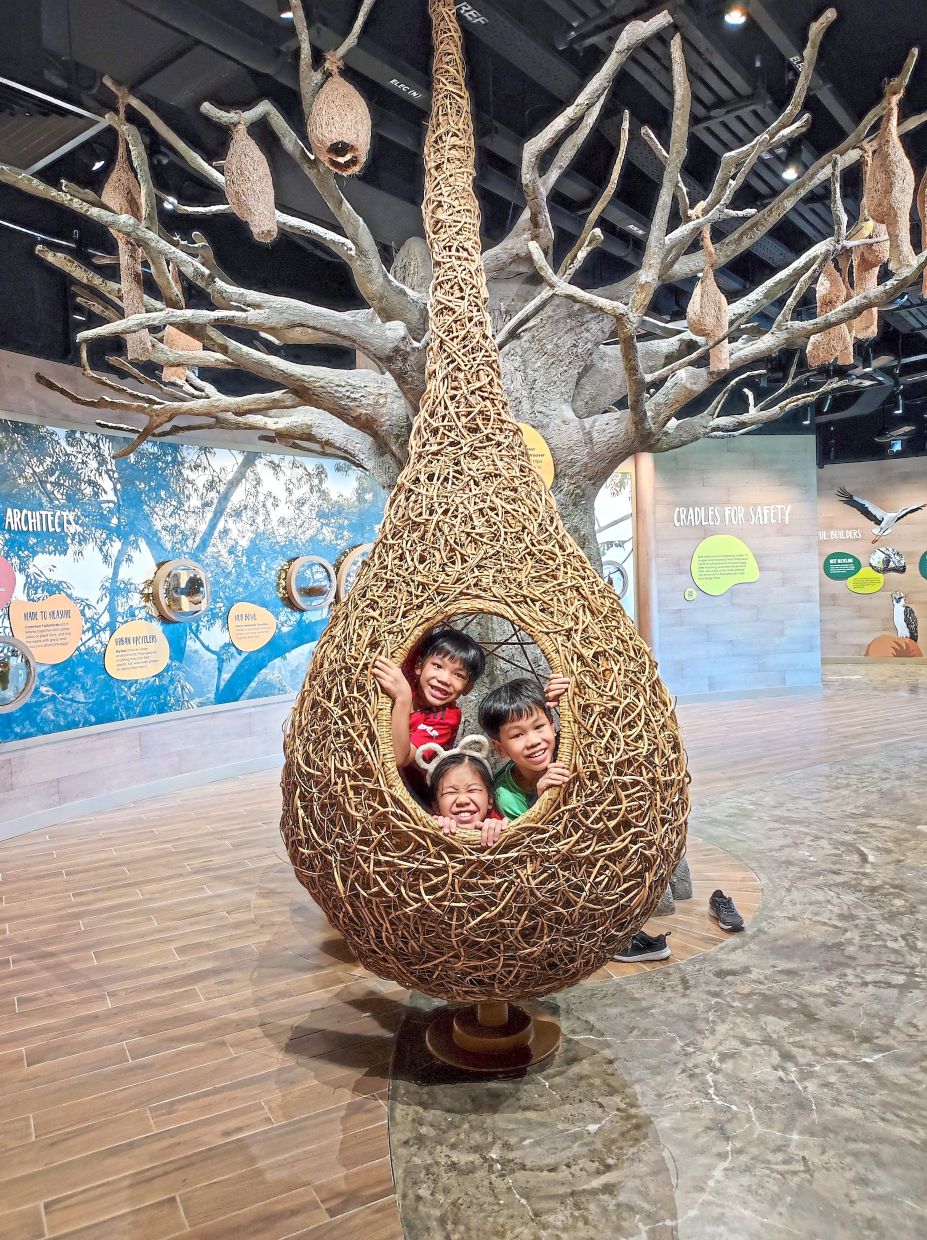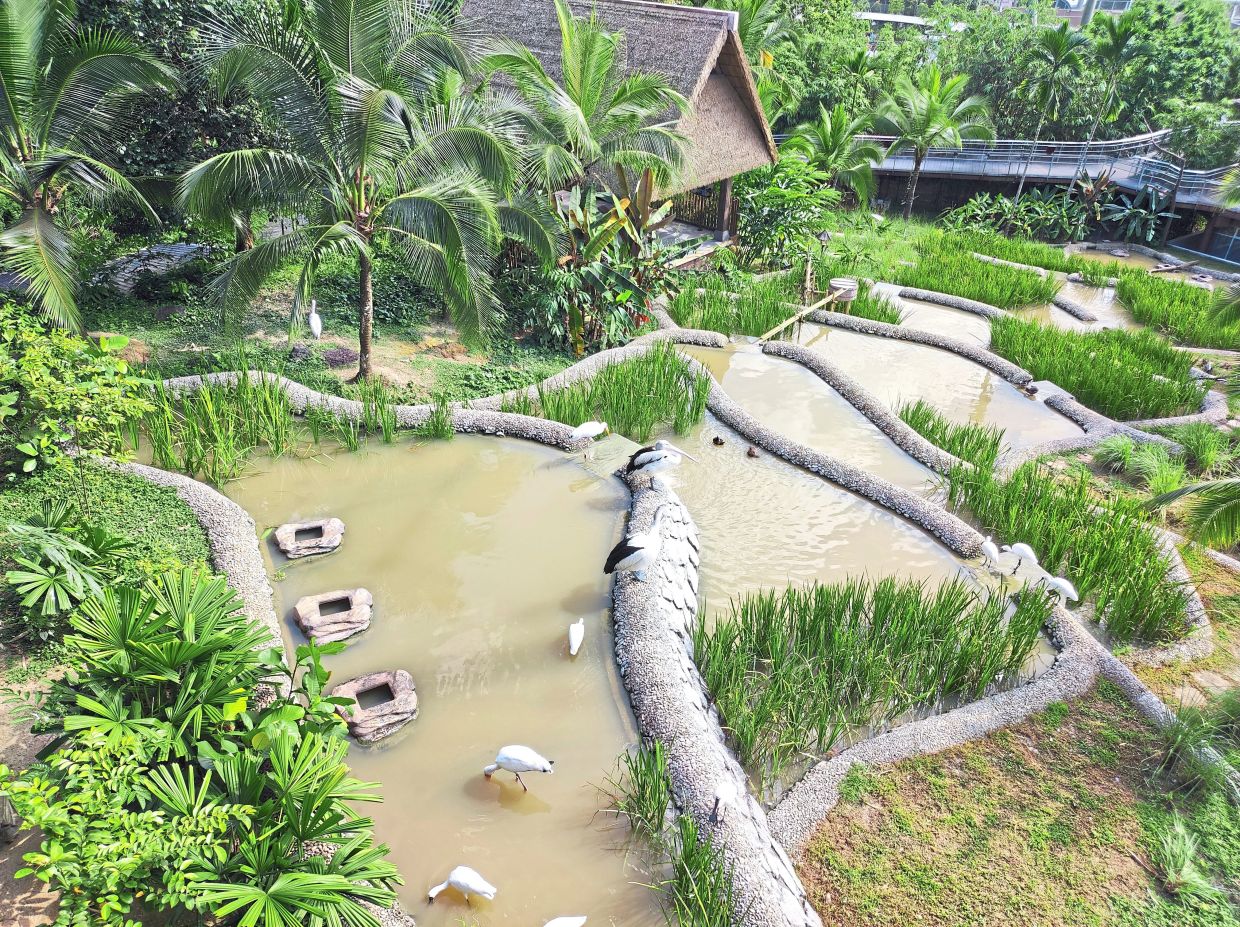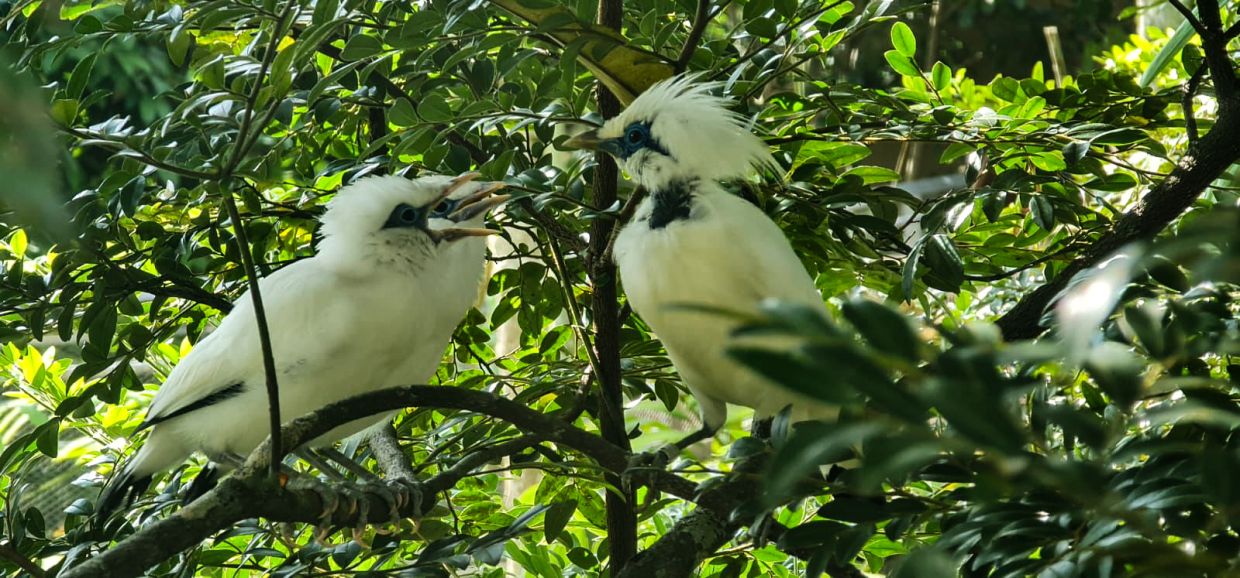Young visitors checking out the penguins at Penguin Cove. — Photos: ANDREA FILMER
“Old Lady! Come, Old Lady! I’ve got fruits.”
Armed with a comb of bananas and full-length clear shields that bear an uncanny resemblance to police riot gear, the keepers took their places around an enclosure at the former Jurong Bird Park in Singapore.
Blanketed by the darkness accompanying the 3am hour, it was time to attempt one of the most daunting bird transfers the team had lined up – the park’s two southern cassowaries.
Eclipsed only by the ostrich in terms of weight, the flightless cassowary grows as tall as a human and is said to be the most similar bird to the ancient dinosaurs.
Indeed, the entire make-up of this creature is magnificent; from its midnight black plumage, long neck and bright blue face, right down to the lethal, dagger-like claws on their three-toed feet.
Often described (rightly or wrongly) as the most dangerous bird on Earth, a single kick could easily do serious harm to a person, if not worse.
But, as the Mandai Wildlife Group keepers have found, they really do like baths. And bananas.
Over the prior months, the keepers had used both to conduct crate training on the cassowaries, conditioning the birds to enter the moving boxes on their own to reduce the stress of their relocation.
But move they must, for an awe-inspiring, new home awaited in the north of Singapore.
Poultry in motion
The Jurong Bird Park opened to the public in 1971 as Asia’s largest bird park.
Over the next five decades, it expanded its aviaries to welcome dignitaries, visitors and new, exotic birds from all over the world.
From flamingos to penguins, and toucans to Santa Cruz ground doves, the park pushed the envelope in showcasing its conservation endeavours alongside the footfalls, delighting over 40 million visitors who passed through its doors.
Around 2015, the Mandai Rejuvenation project was mooted with the aim of establishing an integrated wildlife and nature heritage precinct in Singapore. It would contain the existing Singapore Zoo, Night Safari and River Safari in the area along with a new Rainforest Wild adventure park and Bird Paradise – the new home for the inhabitants of the iconic Jurong Bird Park.
Mandai Wildlife Group vice president of animal care Dr Luis Carlos Neves says the new bird park would allow for species conservation efforts to be scaled up, building upon the decades of good work done in Jurong.
“With over 3,000 individual birds to move, planning for the move took more than a year to strategise for the wide range of bird species, each with differing needs.
“The process involved planning the necessary steps, determining the possible risks and actions needed to actively mitigate them, while establishing the best sequence to conduct the move,” he says.
The translocation process began on Jan 3, 2023, the 52nd anniversary of the Jurong Bird Park and the very day it bid farewell.
Dr Neves says the birds were moved out in phases, starting with the birds in the breeding research centre and off-exhibit breeding facilities, followed by the various aviaries, which went through a pre-determined sequence that coincided with the readiness of the aviaries at Bird Paradise.
To say it was a mammoth task would be an understatement.
While some birds were cooperative, others required stealth and good-natured cunning on the keepers’ part to make the move successful.
There was also the issue of moving unhatched eggs, fledglings and birds with specific environmental needs, like the penguins.
Dr Neves says an air-conditioned truck was commissioned for the penguins while the flamingos were transported in groups in a padded truck, instead of being put in individual crates.
Though the ride was harrowing for the keepers whose hearts jumped at every turn, the method proved highly successful with zero injuries to the birds.
“Larger bird species such as the cassowary was one of the more challenging species to move. Aside from their size, they are also known to be prone to stress under enclosed environments and they are potentially very dangerous animals, so additional layers of safety for both birds and caretakers needed to be in place,” Dr Neves said.
The extensive work on crate training (and the lure of bananas) paid off in the end, with Old Lady coming close enough to be gently encouraged into the moving box.
The second, younger cassowary proved more jumpy, darting from one end of the enclosure to another, but was also successfully guided into a waiting crate.
Both birds are now well settled and can be seen at Bird Paradise.
Part of the flock
A fully immersive experience was the goal in building the new Bird Paradise.
Putting it simply, as a Mandai Wildlife Group guide did on one of the tours, instead of being on the outside, looking in on the birds, the new park aimed at putting visitors inside, with the birds.
From eight walk-through aviaries to choose from and an additional two zones, namely the Penguin Cove and Winged Sanctuary, exploring Bird Paradise will take you the whole day, if not more.
The normal route patrons take at the park begins at the Rwanda Nyungwe Forest Heart Of Africa, to the right of the entrance.
Inspired by the continent’s forest valleys, this aviary is the largest in the park, spanning 1.55ha and is designed around an elevated canopy experience complete with suspension bridges and a viewing tower.
Here, the colourful turacos congregate, showing off their brilliant blues, greens and purples and their groovy, mohawk-looking crests.
After that, it’s a hop and a step over to the Kuok Group Wings Of Asia.
Sporting bamboo trees and sloping rice terraces, this aviary pays homage to the diverse habitats of South-East Asia, giving threatened species like the black-faced spoonbills and Baer’s pochard a place to shine.
The Central Plaza can be seen here, along with Egg Splash, representing the dry and wet play areas for children that the park has to offer.
Beyond that is the Sky Amphitheatre and at the topmost tip of the park, the glorious Hong Leong Foundation Crimson Wetlands.
Entering this enclosure will take your breath away as dozens of pink American flamingos amble along a river with a roaring waterfall emerging in the background.
Almost close enough to touch, visitors to this aviary could be content with feasting their eyes on these long-legged birds alone, until they catch flashes of brilliant red from the scarlet ibis.
A total of 40 species hailing from the South American wetlands, including several of the ever-popular macaw, live side-by-side in this aviary that also holds keeper talks every day at noon.
Turning back to the direction of the entrance, the Amazonian Jewels and Songs Of The Forest aviaries are next.
The former seeks to mimic a scene from the rainforests of South Africa, featuring a majestic buttress root plant, easily recognisable by its huge, visible roots spreading in every direction.
The latter, on the other hand, features gentle streams and large overhanging canopies in an ode to the forests of South-East Asia.
The popular Lory Loft enclosure lies next door, located close to the shuttle station where visitors can ride up from the park entrance.
Lory Loft inherited its name from its beloved predecessor at the Jurong Bird Park.
Here, the monsoon forest of Irian Jaya whispers through the leaves as sociable lories soar from branch to branch and confident parrots fly so close, they sometimes brush the heads of awestruck visitors.
The Mysterious Papua is next on the list and although smaller than some of the other aviaries, it can hold its own in the noise department as a bevy of cockatoos calls this place home.
This exhibit also, of course, houses the two impressive Southern cassowaries transported safely from the Jurong Bird Park in the dead of the night.
Rounding off the aviaries is the Shaw Foundation Australian Outback where towering rock structures provide the perfect backdrop to get up close to the furry kookaburra with its iconic laugh.
And right beside the entrance are the final areas of the park to explore.
One is the Winged Sanctuary that houses more than 100 species of birds and highlights rare and predatory species of high conservation value as well as various bird-of-paradise species.
This area in particular showcases the conservation work done by the park along with its outreach and education projects.
And last but definitely not least is the Ocean Network Express Penguin Cove, a favourite among younger visitors.
Consisting of two levels, visitors can watch the penguins lounging and waddling about on “ground” level on the upper storey, before following their dives down to the depths of the cold saltwater enclosure seen from the bottom storey.
It is a truly magical experience, framed by the soft lights that copy the Aurora Australis.
Eggs-pert care
The size of Bird Paradise is impressive and all of the aviaries open to the public are open-air, walk-through enclosures.
Under the Singapore sun, however, things may get rather hot so each exhibit is accompanied by an interactive, air-conditioned rest stop that also allows visitors to read about the history and characteristics of the birds in the aviary.
Visits to Bird Paradise would also not be complete without taking in at least one of the two animal presentations on show everyday.
Be it Predators On Wings or Wings Of The World, these 20-minute shows delight viewers at the Sky Amphitheatre and go far in raising awareness on the threats and dangers faced by birds all over the globe.
“Of the 400 species here, about 24% of species are threatened and the park’s conservation efforts focus on hornbills, Asian songbirds and pigeon species from the Indo-Pacific region.
Bird Paradise holds the largest hornbill living genetic reserve under a single zoological park as well as participates internationally coordinated breeding programmes.
“As a zoo-based conservation organisation, doing all we can to save species from extinction is in our DNA,” Dr Neves says.
He adds that the move to the bigger and enhanced facilities at Bird Paradise also allowed the establishment to grow its capacities for species breeding programmes and develop targeted programmes for threatened species like the crestless fireback and Negros bleeding-heart, named for the splash of red across its white breast.
Aside from that, Bird Paradise offers a guided Bird Discovery Tour and Backstage Pass (Avian Healthcare) where visitors get to go behind the scenes to the avian hospital and breeding centre.
But everyone must do their part, so don’t be surprised if you get put to work at the end and tasked with making lunch for a scarlet macaw.
After opening its doors on May 8 last year in a soft launch, Bird Paradise has welcomed over 600,000 visitors in the following six months.
With promotions linking the park to its sister establishments in the area and more developments expected through to 2025, the sky is indeed the limit.








